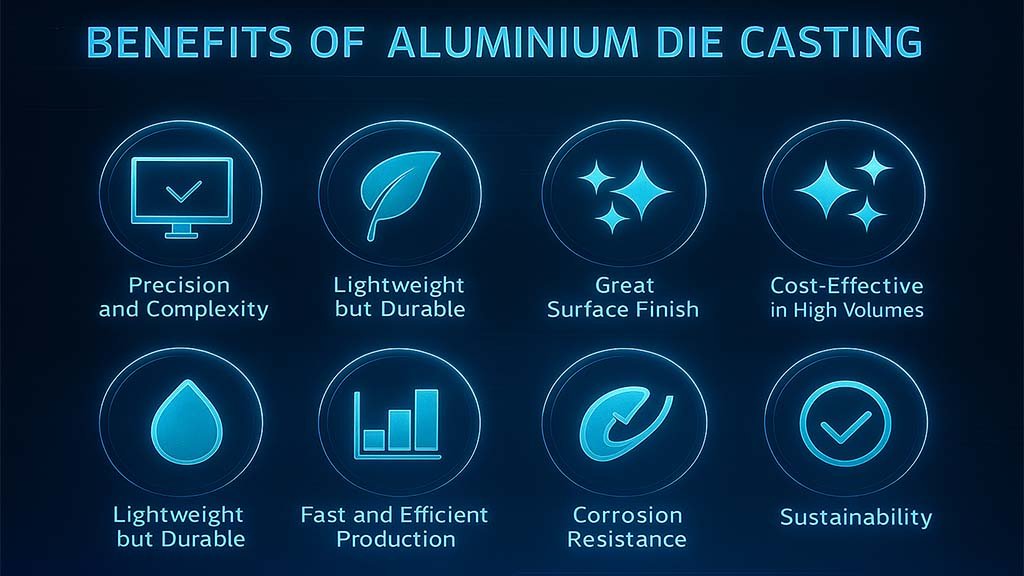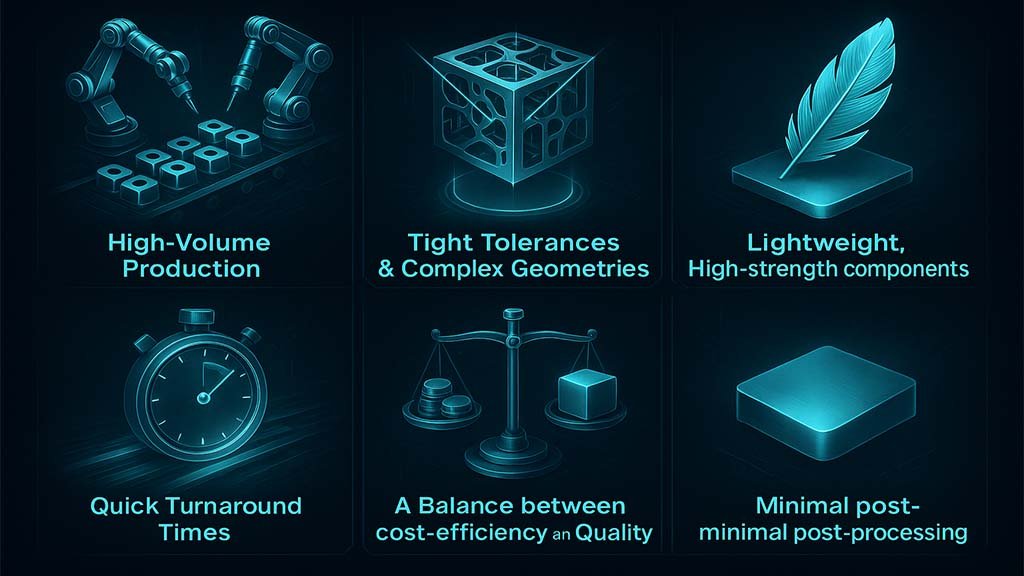In the world of modern manufacturing, efficiency, precision, and cost-effectiveness are key factors when choosing the right production method. One such process that continues to gain popularity across industries is aluminium die casting. From automotive and aerospace to electronics and consumer goods, this method is widely adopted for its ability to produce complex, high-strength components at scale.
But is aluminium die casting the right fit for your specific manufacturing needs? In this blog, we’ll explore what makes this process so effective, its advantages, and how working with experienced aluminium die casting manufacturers can elevate your production capabilities.
Aluminium die casting is a process in which molten aluminium is injected into a steel mold — called a die — under high pressure. The metal then cools and solidifies to form a part that mirrors the exact shape of the mold cavity. Once cooled, the part is ejected, trimmed, and finished as needed.
This method is known for its ability to produce complex, highly detailed, and dimensionally accurate components with smooth surface finishes. Die casting manufacturers prefer this technique for high-volume production where consistency, speed, and strength are essential.
If you’re evaluating whether aluminium die casting fits your manufacturing goals, consider the many benefits it offers:
One of the biggest advantages of aluminium die casting is its ability to create intricate shapes with tight tolerances. It’s especially useful for parts that require fine details, thin walls, or internal features that would be difficult to achieve with other methods.
Aluminium is significantly lighter than steel or iron but still provides excellent strength and rigidity. This makes it ideal for industries like automotive and aerospace, where weight reduction improves performance and fuel efficiency without sacrificing durability.
Once the die is created, the casting process can produce thousands of identical parts quickly. This makes it highly efficient for large-scale manufacturing. The fast cycle times help reduce lead times and ensure quicker deliveries to market.
Parts produced by aluminium die casting usually have a smooth and clean surface, often requiring minimal finishing work. This is particularly important for visible components or those requiring painting, powder coating, or anodizing.
Aluminium forms a natural oxide layer that protects the metal from corrosion. This makes die-cast aluminium parts suitable for applications in humid, wet, or chemically exposed environments.
While the initial investment in tooling can be significant, aluminium die casting becomes increasingly cost-effective in high-volume production. The low per-unit cost, minimal material waste, and reduced need for secondary operations make it an economically sound choice.
Aluminium is 100% recyclable, and many aluminium die casting manufacturers use recycled aluminium in their operations. This makes the process more environmentally friendly while also helping to lower production costs.

Aluminium die casting is ideal if your business requires:
However, if you’re producing very low quantities or oversized components, other processes like CNC machining or sand casting might be more appropriate.
Before deciding, it’s crucial to consult with experienced die casting manufacturers who can evaluate your project requirements and recommend the best approach based on design, volume, and budget.

Choosing the right manufacturing partner is just as important as choosing the process. A skilled and experienced die casting manufacturer can help optimize your part designs, reduce costs, and improve overall product quality.
OME Verma Industries is one of the top aluminium die casting manufacturers in India, known for delivering high-quality die cast components across various sectors. With advanced facilities, cutting-edge machinery, and a commitment to precision, OME Verma Industries ensures your manufacturing goals are met efficiently and reliably.
If you’re considering aluminium die casting for your next project, reach out to OME Verma Industries — where innovation meets precision in every cast.
Zinc die casting is a widely adopted manufacturing process that plays a crucial role in producing high-quality, durable metal parts across numerous industries. Known for its precision, strength, and efficiency, this method is extensively used in automotive, electronics, consumer appliances, and more. With growing demand for complex components and fast production cycles, Zinc Die Casting Manufacturers in India are increasingly delivering world-class solutions that meet global standards. In this article, we’ll explore how zinc die casting works and its vital contribution to modern industry.
Zinc die casting is a metal casting process that involves forcing molten zinc alloys into high-precision steel molds, known as dies, under high pressure. These dies are designed to produce parts with complex geometries and tight tolerances. Once the metal cools and solidifies, the mold opens and ejects the finished part, which often requires minimal machining or finishing.
Zinc alloys like Zamak 3, Zamak 5, and ZA-8 are preferred for their excellent fluidity, corrosion resistance, and mechanical strength—qualities that make them ideal for high-performance components.
Understanding how zinc die casting works involves examining a series of carefully controlled steps. Here’s a breakdown of the process:
The die (mold) is first cleaned, preheated, and lubricated. Preheating ensures even metal flow and reduces thermal shock, while lubrication helps with part ejection and increases mold life.
Molten zinc alloy, heated to a temperature around 400–450°C, is injected into the mold cavity at high pressure (usually between 1,500 and 30,000 psi). This pressure forces the metal into every detail of the mold, filling intricate designs and thin walls with precision.
Once the cavity is filled, the molten zinc quickly cools and solidifies into the desired shape. Zinc’s fast cooling rate contributes to shorter cycle times, which boosts manufacturing efficiency.
After solidification, the die opens, and ejector pins push the part out of the mold. The cycle then repeats for the next part, making zinc die casting ideal for high-volume production.
Excess material, known as flash, is trimmed off, and parts may undergo surface treatments like plating, painting, or powder coating to enhance their appearance and performance.

Zinc die casting offers a powerful combination of qualities that make it indispensable in modern manufacturing. Here’s why many industries choose it:
Zinc die casting supports intricate detailing, thin walls, and tight tolerances—perfect for electronic connectors, mechanical gears, and small housings.
Zinc alloys are strong and impact-resistant, making them suitable for structural and load-bearing parts in automotive and industrial machinery.
The natural smooth finish of zinc castings reduces the need for secondary processing and makes the parts suitable for visible applications.
Fast cycle times and long mold life make zinc die casting cost-effective for large-scale production.
Zinc is 100% recyclable with no loss in quality, and many Zinc Die Casting Manufacturers in India are incorporating eco-friendly practices to reduce waste and energy use.

Zinc die casting is used in a wide variety of industries:
Its versatility, strength, and cost-efficiency make it ideal for both functional and aesthetic applications.

India is home to many top-tier manufacturers that specialize in zinc die casting, offering competitive pricing, technological expertise, and tailored solutions for domestic and global clients. These Zinc Die Casting Manufacturers in India use advanced machinery and strict quality control to meet the evolving demands of multiple industries.
For those seeking a reliable and experienced partner in die casting, OME Verma Industries stands out. Recognized as Leading Aluminium Die Casting Manufacturers in India, they bring the same level of precision, quality, and innovation to every project, ensuring superior results and long-term reliability.